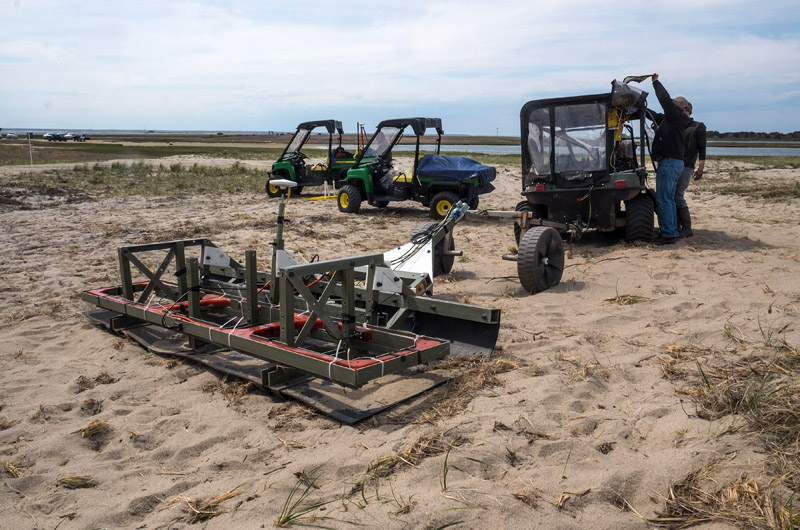The remote northern end of Chappaquiddick has been bustling with activity this spring as the Army Corps of Engineers begins a lengthy cleanup project of World War II-era practice bombs.
The $8.1 million project involves clearing 234 acres in the Little Neck area at Cape Pogue Wildlife Refuge of munitions and munitions debris that have littered the site for more than 70 years. The project will include an underwater element too, with munitions clearing extending to parts of Cape Pogue Bay.
Little Neck was used as a dive bombing target spot by the U.S. Navy at the end of World War II, beginning in July 1944 and continuing for about two years. Pilots from the U.S. Navy airfields on Martha’s Vineyard and at Quonset Point, R.I. practiced at Little Neck and other parts of the Island’s south shore.
According to the Army Corps, munitions and explosives of concern include three-pound practice bombs, 100-pound practice bombs, and flares.
Project manager Carol Charette said last week that the crew mobilized on the site on March 13 and field work is expected to be completed by December 2016.
Underwater cleanup is expected to begin at the end of June on the inland water areas, she said.
Frequented mostly by fishermen and birdwatchers, the remote stretch of barrier beach is owned by The Trustees of Reservations and has been closed to the public for a number of years for safety reasons because of the munitions. This spring the entire area has been cleared of vegetation, and specially-trained personnel are at work carrying geophysical sensors over the land to find buried munitions.
The sensors emit a signal when objects are detected. Ms. Charette said when items are discovered a map is created and analyzed by a geophysicist, who creates a “dig list.” When the list is approved and items are confirmed as ordnance, they are removed.
Munitions are detonated at Cape Pogue at least once a day and usually a few times each day, Ms. Charette said.
“Once we find these things and uncover them we don’t want to leave them lying around in a pile,” she said. “The safest thing to do is just to detonate them.”

From May 9 through May 14, the crews unearthed and dealt with 60 munitions or explosives of concern, and another 445 pieces of munitions debris. To date 291 munitions of concern had been found, and 1,453 pieces of debris.
Through May 14, 8,529 pounds of material documented as safe, like practice bombs with no energetic material in them, had been found.
Material considered safe is placed in secure storage at the Chappy fire station until there is a full load, Ms. Charette said, at which point the debris is taken off-Island to be recycled.
A crew of about 34 people will be involved in the project, including a team of 20 with GSI Pacific, the prime contractor performing digs and demolition of munitions or explosives. All personnel performing intrusive work are certified unexploded ordnance technicians.
Naeva Geophysics Inc. has a staff of four working on land geophysics, and a staff of three from 3D Geophysics is doing underwater geophysics work.
Starting at the end of May, a crew of about seven unexploded ordnance technicians and certified divers will arrive to start dives to perform underwater digs, Ms. Charette said.
Personnel are staying on Chappy for the duration of the project.
The Trustees of Reservations is providing biologists to help the crews avoid disturbing nesting shorebirds. The Trustees has supported the work being done at Little Neck and hope to reopen the area to visitors in early 2017, when the work is done.
Cedars, alders, bayberry shrubs and beach grass have been cut down at the site. The area will later be replanted with native grasses and shrubs.
The munitions removal at Little Neck is the first of several remediation projects in the works for the Vineyard, where the Army Corps has conducted surveys of sites over the past several years. Last summer the Corps held public hearings on the Island for a $9.8 million proposal to remove munitions at the Tisbury Great Pond. A $622,000 public education and monitoring program is also planned for South Beach in Edgartown.










Comments (10)
Comments
Comment policy »